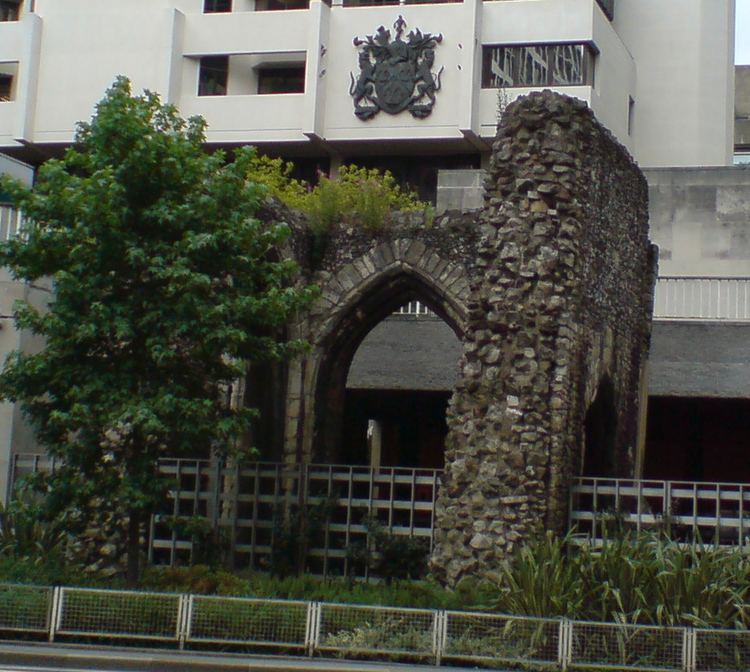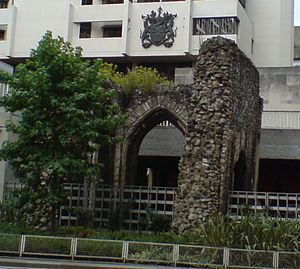Father George Hayward Died 1593 Mother Margaret Whitbrooke Parents George W. Hayward | Buried St Alphage London Wall Name Rowland Hayward | |
 | ||
Spouse(s) Joan TillesworthKatherine Smythe | ||
Place of burial St Alphege London Wall | ||
Sir Rowland Hayward (c. 1520 – 5 December 1593) was a London merchant, and Lord Mayor of the City in both 1570 and 1591. Through his commercial activities he acquired considerable wealth, and was able to loan money to Queen Elizabeth I and purchase properties in several counties as well as houses in and near London. He entertained the Queen at King's Place in 1587.
Contents

Family
Hayward was the eldest son of George Hayward (d.1557) of Bridgnorth, Shropshire, by Margaret Whitbrooke, the daughter of John Whitbrooke. George Hayward carried on the trade of shoemaker in Bridgnorth, was Member of Parliament for Bridgnorth in 1529 and alderman of the town about 1543.
Career
Hayward was educated locally at Bridgnorth Free School. He moved to London when he was about twelve years of age, and was apprenticed to a clothworker, becoming free of the Company of Clothworkers in 1541 or 1542.
In 1558 Hayward attended the Lord Mayor at the coronation banquet of Queen Elizabeth I. In 1559 he was Master of the Clothworkers. In 1560 he was elected Alderman, a dignity to which no citizen worth less than 2000 marks could then attain, and in the same year, together with another Alderman, loaned the City £1000 towards the purchase of wheat. In 1561 he became President of Bridewell Hospital, and remained involved in the administration of London's hospitals until his death. He was elected Sheriff in 1563-4.
Hayward quickly became one of London's "commercial magnates". Before 1563 he was trading with Antwerp. As a member of the Company of Merchant Adventurers he exported English cloth, and imported from abroad coarse materials such as fustian and buckram and luxury fabrics such as camlet and silk. In 1565 he played a role in the founding of the Royal Exchange. In 1567 he was one of the promoters of Sir John Hawkins' third slave-trading voyage. He was a founding member of the Muscovy Company, serving as its Governor on eight occasions during the years 1567–1587. He was named as among its leading merchants in both 1567, when Czar Ivan the Terrible granted the Company a monopoly, and in 1570, when the Shah of Persia granted the Company a similar licence. From 1568 he also served as Governor of the Company of Mineral and Battery Works. In 1570 he was elected Lord Mayor of London, and knighted in 1571. In 1572 he was elected to Parliament, where he played an active role on several committees, and in the same year became President of St Bartholomew's Hospital, a post he continued to hold until his death. In 1582 he was among the investors in Edward Fenton's 'disastrous' voyage to the Far East. He served as Lord Mayor again in 1591, taking over when Sir John Allot died in September without having completed his term.
According to Jay, 'No mention of Sir Rowland's specific services to London can give any idea of his unwearying devotion to the city of his adoption'.
Hayward's increasing wealth from his commercial ventures allowed him to loan money to the Queen, and to acquire considerable property over the years. By 1553 he had purchased property in four counties, some of which had become available through the dissolution of the monasteries. At the time of his death in 1593 he owned seventeen manors in several counties, as well as a house in London and another just outside the City. His London house was on the site of the former Priory of St. Mary the Virgin, founded in 1332 by William Elsing, for canons regular, (originally a Hospital for one hundred blind men, known as "Elsing's 'Spital") situated at the north end of Gayspur Lane, which ran down to London Wall. The Priory was suppressed at the Dissolution of the Monasteries and turned into a mansion house. The house was in Philip Lane, London Wall, and adjoined the church of St Alphage; Hayward purchased it for £700 from Margery Williams, the daughter of John Williams, 1st Baron Williams of Thame, and wife of Henry Norris, 1st Baron Norris. Hayward's country home was King's Place in Hackney, which had earlier been owned by King Henry VIII and was the scene, in July 1536, of a reconciliation between the King and his elder daughter, Mary. Hayward purchased it from Henry Carey, 1st Baron Hunsdon in 1583. In 1587 Hayward entertained Queen Elizabeth at King's Place when she was on her way to Lord Burghley's house of Theobalds.
Hayward died 5 December 1593 at King's Place in Hackney, and was buried at the church of St Alphage London Wall. A monument depicting Hayward with his two wives on either side, each with her eight children, was erected to his memory by two of his executors, William Pilsworth and William Cotton, in the wall of the choir on the south side of the church.
In his will, dated 17 November 1592 and proved 4 March 1594, he left a third of his property to his wife and another third to his children, according to the custom of the City of London, with the remaining third devoted to his own personal bequests, including gifts for charitable purposes. He directed that his house of King's Place in Hackney be sold. In 1596 Elizabeth Trentham, Countess of Oxford, purchased it from his executors; she lived in it for more than a decade, and sold it in 1609 to Fulke Greville, 1st Baron Brooke. Among the overseers named in Hayward's will were Thomas Owen (died 1598) and William Sebright (died 1620).
Marriages and issue
Hayward married firstly Joan Tillesworth (died 1580), the daughter and coheir of the London goldsmith William Tillesworth, by whom, according to the inscription on his monument, he had three sons and two daughters who died as infants, and three surviving daughters:
Hayward married secondly, when she was only sixteen years of age, Katherine Smythe, the daughter of Thomas Smythe, Customer of London, by whom he had a son and a daughter who died as infants, and two surviving sons and four surviving daughters, all young and unmarried at the time of his death:
Here lyeth the body of Edward Crayford esq eldest sonne of Sr Will Crayford of Great Mongeham who by Anne his wife one of the daughters of Sr Rowland Hayward thrice [sic] Lord Maior of London who had yssue will [sic: Willm] George Richard Iohn + Anne, he dyed ye 28th of Sept 1615 of his age ye xxxixth vnto whose memorie Anne his wife hath dedicated this.
After Sir Rowland Hayward's death, his widow, Katherine, married Sir John Scott, son of Sir Thomas Scott.
